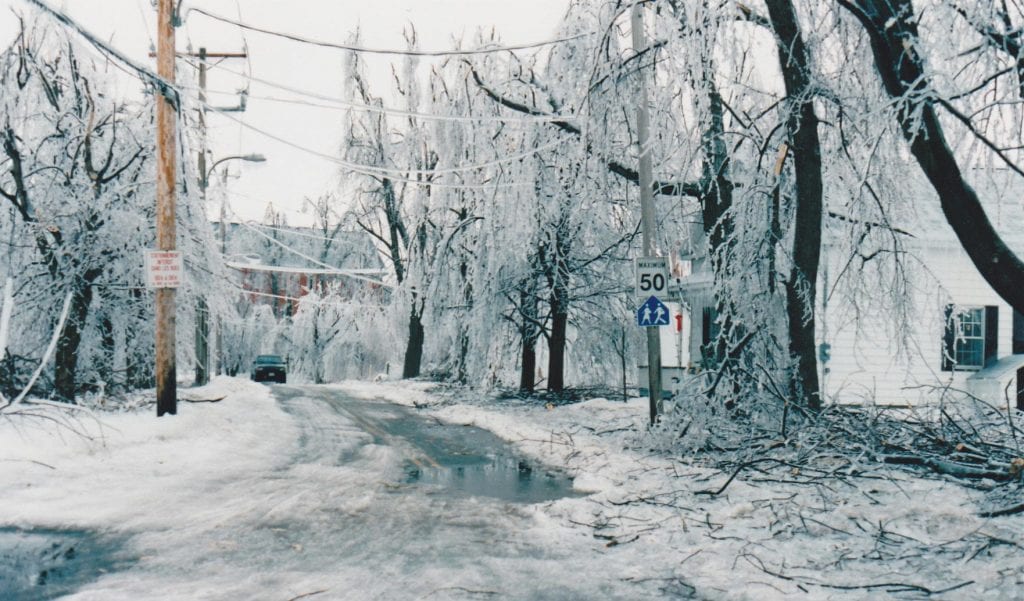
The Saint-Césaire substation was built in 1962 by Southern Canada Power Company Ltd. A year later, the company was purchased by Hydro-Québec, which was nationalizing the electricity supply across the province. A heritage study published in 2015 considers the building to be of high architectural interest. The composition of its facade, in particular, demonstrates a distinct aesthetic quality. For example, there is a regular alternation between the brick covering of the facade and the vertical bands where the windows are positioned. For all these reasons, TransÉnergie (the Hydro-Québec division in charge of the province’s vast transmission system) will take these original architectural choices into account when it decides to expand the building in 2003. It aims to respect the building’s heritage value. Luckily, the ice storm of 1998 does very little damage to the substation and its power transmission facilities. Its capacity will be expanded over the years to meet the increasing needs of the customer base.
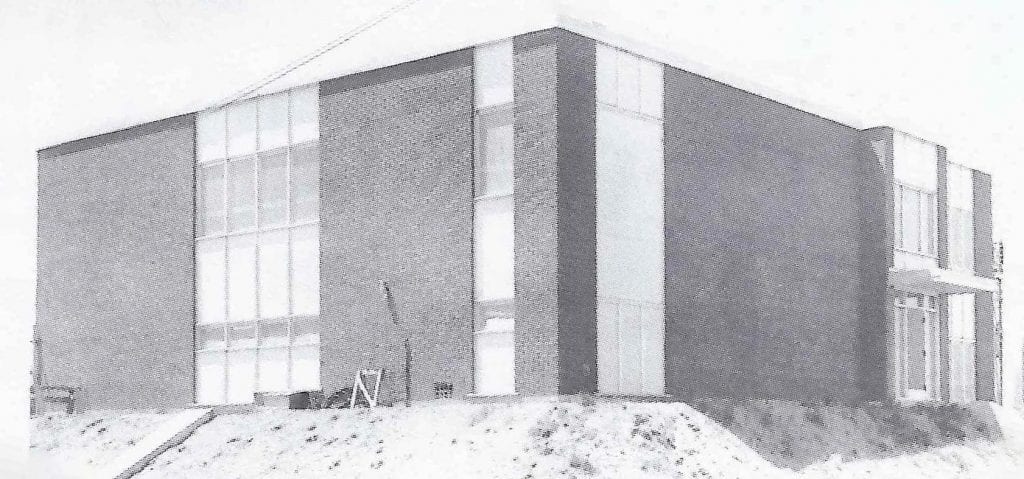
The Saint-Césaire substation constructed in 1962 by the Southern Canada Power Company Ltd.
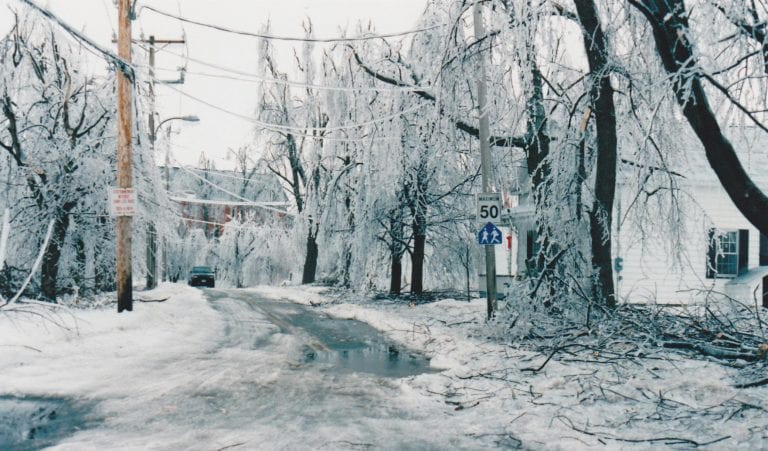
Rue Notre-Dame at the corner of Rue Denicourt in Saint-Césaire.
In the early days of 1998, freezing rain transforms the town of Saint-Césaire into a world of ice. Thousands of tree branches and electrical wires are strewn over the ground. No one can drive through the slippery streets or walk on the icy sidewalks. All the buildings are entombed in ice as well. In the evening, the town is plunged into near-total darkness since no light emanates from most of the homes. However, the great majority of residents are confident that electricity will be restored within a few days. In the meantime, several people head for École Polyvalente P.-G. Ostiguy, now an emergency shelter for residents, because it has its own electricity generator and a gas-powered heating system. Everyone has to eat (a few restaurants are still functioning), stay warm and find accommodation while waiting for better days to arrive. But that will only happen after three weeks of darkness!
During this winter crisis, heating remains the priority for city dwellers. In the countryside, there are added concerns: the farms must stay in operation. In Saint-Césaire and the surrounding area, 48% of the citizens still have a wood-burning stove for their house. The municipality will facilitate their use by providing firewood to residents for free. But many people need to find other ways to keep their homes warm. Buying or renting a gas-powered generator will become a common solution among those affected. The Canadian Army comes to the aid of municipal employees, especially to remove debris from the streets of the town and to lead the work teams who distribute firewood and drinking water. Employees from Connecticut Light and Power will assist Hydro-Québec with restoring service to Saint-Césaire. However, it is above all the generosity and teamwork of the townspeople which make it possible for everyone to come safely through this battle with the ice.
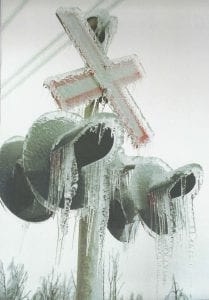
Ice enshrouds a level railway crossing sign (a crossbuck) and its flashing lights on Highway 112.
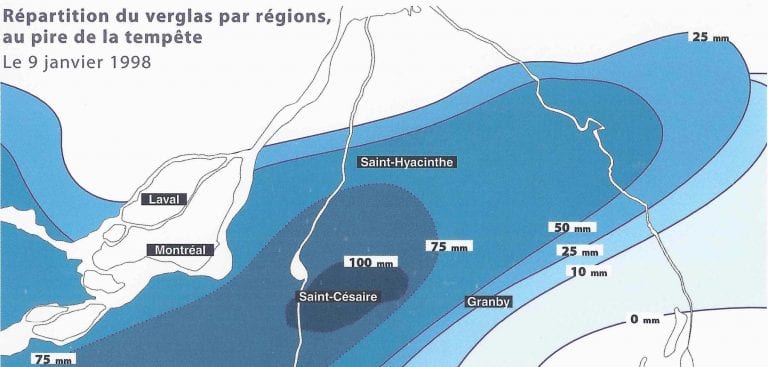
Regional distribution of freezing rain at the height of the ice storm,
January 9, 1998
- On January 9, 1998, nearly 100 mm of freezing rain fell on Saint-Césaire.
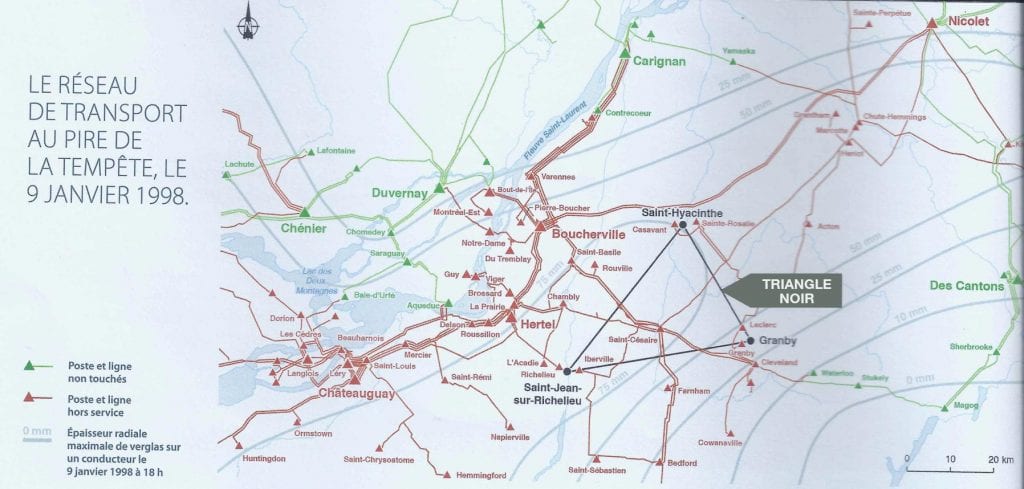
Hydro-Québec map showing the out-of-service utility lines and the “triangle of darkness”.
Quebecers are accustomed to living through periods of freezing rain from time to time, but never like the one people have now dubbed the Great Ice Storm of 1998. The accumulation of nearly 100 mm of ice on Hydro-Québec power lines leads to the cascading collapse of 76 transmission towers between the Boucherville and Saint-Césaire substations and to the loss of 230 kV in power supply. This extreme weather phenomenon also causes the loss of fourteen 120-kV power lines covering the eastern territory of the Beloeil–Saint-Hyacinthe axis up to the American border and serving 89 municipalities between Saint-Hyacinthe, Saint-Jean-sur-Richelieu and Granby. Secondary power lines are also badly damaged: 14,000 wooden utility poles have broken and hundreds of transformers have exploded. As night falls on January 9, all across Quebec, 1.4 million homes in over 700 municipalities are in the dark. It is only on Sunday, January 25, 1998, that the Saint-Césaire substation will be powered up once more and can begin to gradually restore electricity to its 300,000 customers. The next day, around 10 to 15 percent of Saint-Césaire’s electricity subscribers will be connected to the grid again. The work to re-establish service will continue over the days that follow.
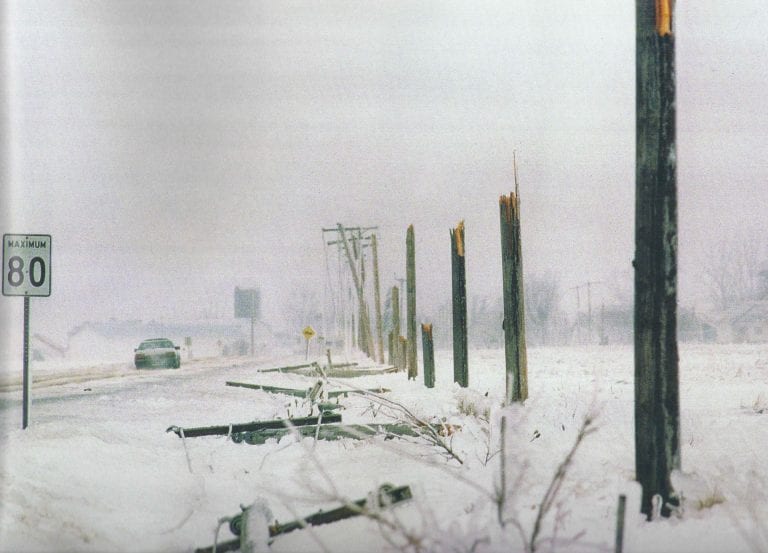
Utility poles snapped under the weight of ice and wind lie broken alongside Highway 112 in Saint-Césaire.
Mr. Jean-Pierre Desnoyers recounts his experience: “Early in January, everyone was returning to work after the holidays. The skies were cloudy, and freezing rain had begun to fall on southern Quebec. In previous days, the Radio-Canada weatherman had sounded a fearful note about the upcoming weather conditions: “Something quite ugly is about to hit us.” The freezing rain lasted several days and the ice accumulated on the trees and the utility wires. The tree branches were breaking with a terrible cracking noise and then the worst happened — I saw the huge transmission towers collapse into the fields behind us. I knew this would mean no electricity for a long blackout period, and since we had no other way of heating our home, we went to live with my in-laws. We had to go back to living the way people did in the past, such as cooking our meals on a wood stove and lighting our rooms with an oil-burning lamp. To stop things from rotting, we had to empty the refrigerators and freezers and store the food in boxes outside. Without electricity, we had no access to news broadcasts on radio or television. So we listened to reports over the car radio. The streets of Saint-Césaire were completely dark in the evenings. When army trucks started rolling through the town’s ice-covered streets, it felt like a war was happening. People were racing to the stores to buy food and generators. The gymnasium and the school rooms offered emergency shelter to families with no heating or electricity. All of these scenes are imprinted on my memory, it’s an episode of my life I cannot forget. My sector had no electricity from January 6 to January 31, 1998.”
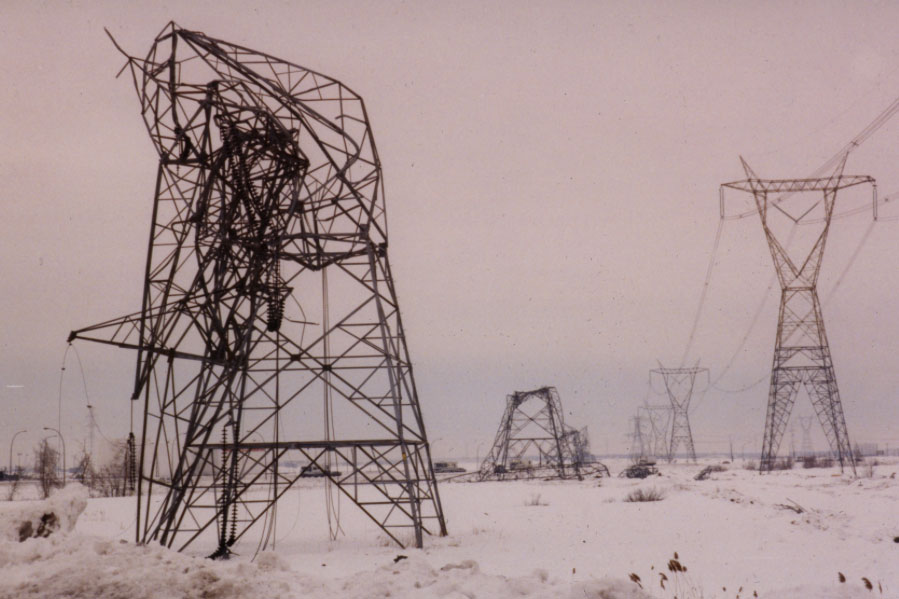
Transmission towers downed by freezing rain along the live power line from Saint-Césaire to Boucherville.
Location of the pannel on La Route des Champs



Research and text
Gilles Bachand, historian
Société d'histoire et de généalogie des Quatres Lieux
References and photographs (2020)
Archives of the Société d’histoire et de généalogie des Quatre Lieux
Archives of the Société d’histoire de la Seigneurie de Monnoir